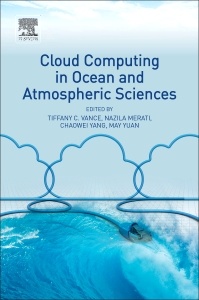Cloud Computing in Ocean and Atmospheric Sciences
Coordonnateurs : Vance Tiffany C, Merati Nazila, Yang Chaowei, Yuan May

Cloud Computing in Ocean and Atmospheric Sciences provides the latest information on this relatively new platform for scientific computing, which has great possibilities and challenges, including pricing and deployments costs and applications that are often presented as primarily business oriented. In addition, scientific users may be very familiar with these types of models and applications, but relatively unfamiliar with the intricacies of the hardware platforms they use.
The book provides a range of practical examples of cloud applications that are written to be accessible to practitioners, researchers, and students in affiliated fields. By providing general information on the use of the cloud for oceanographic and atmospheric computing, as well as examples of specific applications, this book encourages and educates potential users of the cloud. The chapters provide an introduction to the practical aspects of deploying in the cloud, also providing examples of workflows and techniques that can be reused in new projects.
Foreword
List of Contributors/Author biographies
Dedication
Acknowledgements
Introduction
1. A Primer on cloud computing
2. Analysis patterns for cloud centric atmospheric and ocean research
3. Forces and Patterns In The Scientific Cloud: Recent History and Beyond
4. Data-driven Atmospheric Sciences using Cloud-based Cyberinfrastructure: Plans, opportunities, and challenges for a real-time weather data facility
5. Supporting marine sciences with Cloud services: technical feasibility and challenges
6. How we used cloud services to develop a 4D browser visualisation of environmental data at the Met Office Informatics Lab
7. Cloud computing in Education
8. Cloud computing for the distribution of numerical weather predictions outputs
9. A2CI: A Cloud-based, Service-oriented Geospatial Cyberinfrastructure to Support Atmospheric Research
10. Polar CI Portal: A Cloud-based Polar Resource Discovery Engine
11. Climate analytics as a service
12. Using cloud-based analytics to save lives
13. Hadoop in Cloud to Analyze Climate Datasets
14. LiveOcean
15. Usage of Social Media and Cloud Computing during Natural Hazards
16. Dubai Operational Forecasting System in Amazon cloud
17. Utilizing cloud computing to support scalable atmospheric modeling: A case study of cloud-enabled ModelE
18. ERMA to the cloud
19. A Distributed, RESTful Data Service in the Cloud in a Federal Environment: A Cautionary Tale
20. Conclusions and the road ahead
Nazila Merati is an innovator successful at marketing and executing uses of technology in science. She focuses on peer data sharing for scientific data, integrating social media information for science research and model validation. Nazila has more than 20 years of experience in marine data discovery and integration, geospatial data modeling and visualization, data stewardship including metadata development and curation, cloud computing and social media analytics and strategy. She is the past chair of the Environmental Information Processing Technologies Conference of the American Meteorological Society where she organized sessions on cloud computing, crowdsourcing and social media for atmospheric research and GIS applications. She has received research funding for the rescue of oceanographic data and application of advanced technologies to oceanographic research. She received Masters in both fisheries oceanography and landscape architecture from the University of Washington.
Chaowei Phil Yang is Profess
- Provides real examples that help new users quickly understand the cloud and provide guidance for new projects
- Presents proof of the usability of the techniques and a clear path to adoption of the techniques by other researchers
- Includes real research and development examples
- that are ideal for cloud computing adopters in ocean and atmospheric domains
Date de parution : 03-2016
Ouvrage de 454 p.
15x22.8 cm
Thèmes de Cloud Computing in Ocean and Atmospheric Sciences :
Mots-clés :
Acidification; Amazon EC2; Analysis patterns; Apache Hadoop; Archive management; Atmospheric sciences; Azure; Big data; Climate change; Climate dataset; Climate models; Climate reanalysis; Cloud computing; Cloud workflow; Cloud; Cloud-first policy; Cloud-supported Big Data Mobile computing; Coastal; Collaboration; Crawler; Cyberinfrastructure; DaaS; Data analysis; Data harvesting; Data interoperability; Data management; Data mining; Data portal; Data services; Data-intensive computing; Disaster coordination; Disaster management; Disaster relief; Dubai; Education; E-learning; Ensemble mean; Ensemble patterns; Environmental data; Environmental response and recovery; ERDDAP; ERMA; e-Science; Estuary; Federal GeoCloud project; Fisheries; Flood prediction; Fog computing; GIS Hadoop; GIS spatial analysis; Hadoop; HDF; HEC; High-end computing; High-performance computing; HPC; Hydrology; IaaS; Infrastructure as a Service; Innovation; Interactive visualization; Interoperability; IPCC; Learning management system; LiveOcean; LMS; Machine learning; MapReduce; MERRA; MetOcean; Model evaluation; Model; ModelE; Modeling; NetCDF; Network; NOAA; Numerical weather predictions; OAIS; Oceanography; On-line instruments; OOICI; Paradigm; Pattern language; Persian Gulf; Polar cyberinfrastructure; Processing service; Products; Quality of service; Real-time; Reanalysis; Remote sensing imagery; Reproducibility; Research; Resource discovery; ROMS; SaaS; Scientific cloud computing; Scientific workflow; Sea surface temperature; Semantics; Service-oriented; Shellfish; Social media; Spatial big data; Spatial data; SWAN; Temporal data; Unidata; United Arab Emirates; Visualization tool; Visualization; Weather forecasts; Weather; Web data services; Web-based GIS; WebGL; WRF; XaaS



